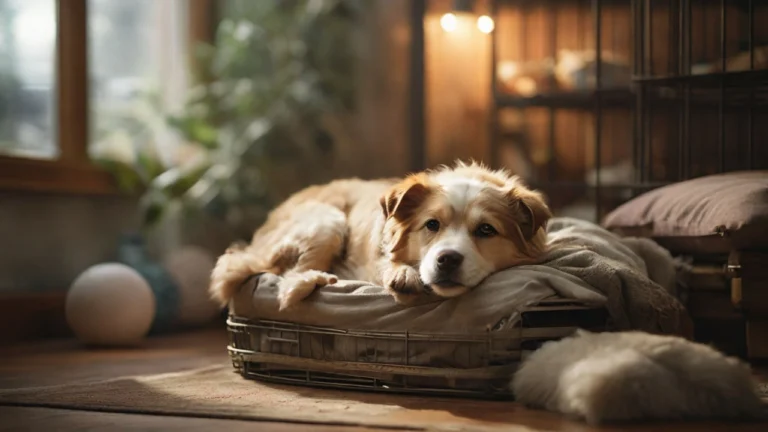If you have a dog, you might have wondered how to train your dog to sleep in a crate. A crate can be valuable for providing your dog with a safe and comfortable place to rest, especially at night. However, not all dogs are naturally inclined to sleep in a crate; some may need guidance and encouragement.
This article will explain the benefits of crate training your dog, the steps to follow to make your dog love their crate, and the common mistakes to avoid when crate training your dog. By the end of this article, you will have a clear idea of how to train your dog to sleep in a crate and enjoy it.
Crating Caution
Crating your dog can be a beneficial way to teach them good habits, provide them with a haven, and prevent them from getting into trouble. However, crating your dog also comes with some risks and challenges you must know. For instance, crating your dog for too long can cause them to develop behavioral problems, such as anxiety, aggression, or depression. Crating your dog incorrectly can also make them hate their crate or associate it with fear or punishment. Therefore, you must follow some basic rules and tips when crating your dog to ensure that you do it humanely and effectively.
Crate Selection
One of the first steps to crate training your dog is to choose the right crate for them. The crate should be large enough for your dog to stand up, turn around, and lie down comfortably but not so large that they can use one corner as a bathroom. The crate should also be sturdy, secure, and easy to clean. Depending on your preference and budget, you can choose from different types of crates, such as wire, plastic, or fabric. Adding some bedding, toys, or treats to the crate makes it cozier and appealing for your dog.
The Training Process
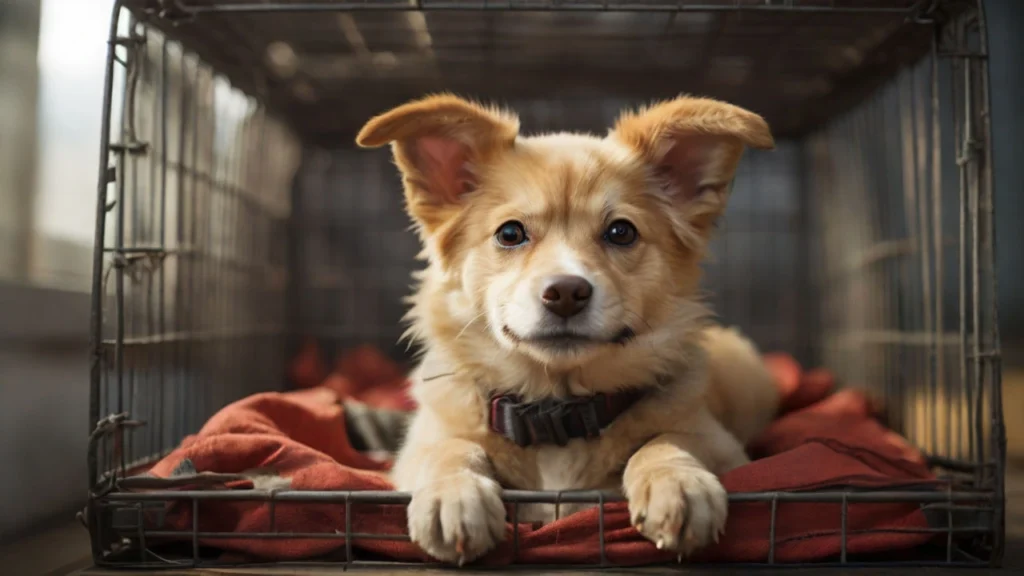
The training process for crate training your dog consists of four main steps:
- Introducing your dog to the crate.
- Feeding your dog meals in the crate.
- Practicing with more extended crating periods.
- Crating your dog when you leave or at night.
These steps should be done gradually, positively, and patiently to help your dog adjust to and learn to love the crate. It would help never to force your dog into the crate or use it as a punishment. You should also monitor your dog’s behavior and reactions and adjust the training accordingly.
Step 1: Introduce Your Dog to the Crate
The first step to crate training your dog is to introduce them to the crate calmly and casually. You can place the crate in a familiar and comfortable area, such as the living room or the bedroom, and leave the door open. You can also put treats, toys, or a blanket inside the crate to entice your dog to explore it. You can praise and reward your dog whenever they approach, enter, or stay in the crate to reinforce the positive association. You can also use a cue word, such as “crate” or “bed,” to label the crate and help your dog learn what it is. You should let your dog explore the crate at their own pace and not rush or pressure them.
Step 2: Feed Your Dog Meals in the Crate
Feed Your Dog Meals in the Crate: The next step to crate training your dog is to feed them their meals in the crate. This will help your dog associate the crate with something pleasant and rewarding and make them more willing to stay in it. You can start by placing the food bowl near the crate’s entrance and gradually moving it inside until your dog eats comfortably. You can close the crate door while your dog eats and open it as soon as they finish to get them used to being in the crate with the door closed. You can gradually increase the time the door is closed as long as your dog is calm and relaxed. You should always praise and reward your dog for eating in the crate and never disturb or interrupt them.
Step 3: Practice with Longer Crating Periods
Once your dog is comfortable eating in the crate, you can start to practice with more extended crating periods. You can do this by giving your dog a treat or a toy and closing the crate door for a few minutes. You can then open the door and praise your dog for being calm and quiet. You can gradually increase the duration of the crating periods as long as your dog shows no signs of distress or anxiety. It would help if you always kept an eye on your dog and never left them alone in the crate longer than they can handle. It would help if you also varied the times of the day that you crate your dog to avoid creating a predictable pattern.
Step 4: Crate Your Dog When You Leave
When your dog is ready to be crated for extended periods, you can start creating them when you leave the house. This will help your dog feel secure and prevent them from getting into trouble when you are not around. You should follow the same steps as before by giving your dog a treat or a toy and closing the crate door. It would help to keep your departures and arrivals low-key to avoid triggering separation anxiety in your dog. It would help if you did not make a big fuss when you leave or return, as this will only excite or stress your dog. You should also not crate your dog for more than a few hours and ensure they have enough exercise and stimulation before and after crating.
Step 5: Crate Your Dog at Night
Crate Your Dog at Night: The final step to training your dog is to crate them at night. This will help your dog sleep better and avoid accidents or disturbances at night. You should follow the same steps as before by giving your dog a treat or a toy and closing the crate door. You should also make sure your dog has a last potty break before bed and that they are tired and relaxed. It would help to place the crate in a quiet, dark area where your dog can still see or hear you. It would help if you did not crate your dog in a different room, as this will make them feel isolated and scared. You should also only respond to whining or barking from your dog if they need to go outside. You should ignore attention-seeking behavior and reward your dog for being calm and quiet.
Potential Problems
Crate training your dog can be smooth and easy if you follow the abovementioned steps and tips. However, you may encounter problems or challenges you must be prepared for. Some of the common issues that crate training can cause are:
- Your dog hates the crate and refuses to go in or stay in it.
- Your dog has accidents in the crate or soils their bedding or toys.
- Your dog barks, whines, or howls in the crate, disturbing you or your neighbors.
- Your dog chews, scratches, or tries to escape from the crate and injures themselves or damages the crate.
- Your dog develops separation anxiety and becomes stressed or depressed when you leave them in the crate.
- Your dog becomes dependent on the crate and cannot cope without it.
Find the Right Spot for the Crate
Your puppy needs a good place to put their crate. The crate should be in a place that is not loud or crowded but has some things your puppy knows and likes. Your puppy should be able to see you or hear you from the crate. Do not put the crate where your puppy is alone or afraid. Move the crate slightly because your puppy might get confused and feel unsafe. Keep the crate in one place unless you need to move it.
Avoid Food & Water Before Bedtime
Your puppy may want to go out at night if they have too much food or water before bed. This can make their tummy full and hurt. Do not give your puppy anything to eat or drink for two hours before bed to stop this. You should also check that your puppy has peed and pooped before going into the crate. This will make it less likely that they will mess up or need to go out at night.
Wear Your Puppy Out
Your puppy may not sleep well in the crate if they have a lot of energy and fun. This can make them move around and not stay still. To fix this, you should help your puppy have fun and exercise during the day, especially before bed. You should have fun with your puppy, walk, teach them some things, or play games. This will make your puppy use up some of their energy and make them sleepy and calm. A sleepy puppy is a good puppy, and a good puppy is likelier to sleep well in the crate.
Don’t Play with Your Puppy at Night
Your puppy will sleep better in the crate if you do not play with them at night. Playing with your puppy can make them awake and happy, which can stop them from sleeping. Instead, you should make the nighttime peaceful and silent and only talk to your puppy about peeing and pooping or if something is wrong. You should also not look at or touch your puppy when they are in the crate, as this can make them cry or shout for more. It would help if you only treat your puppy for being still and silent in the crate and not paying attention to any noise they make.
Wake Up Before Your Puppy
Your puppy will learn to love the crate if you wake up before them every day. This way, you can start the day and help your puppy when they need you. This makes your puppy feel safe and happy and makes it less likely that they will make loud noises when they wake up.
Be Consistent & Patient
Your puppy will learn to like the crate if you do the same thing daily. Make the crate a good place for your puppy. Be patient as your puppy gets used to the new place. Do not change the way you train your puppy, and keep trying.
Where Should You Put Your Puppy’s Crate at Nighttime?
Your puppy needs a good place to sleep in the crate at night. You can first put the crate in your room to make your puppy feel less lonely. Slowly, as your puppy gets used to the crate, you can move it to a place that is not loud, cozy and has nothing to bother your puppy.
What Should You Do If Your Puppy Whines Or Barks In Their Crate?
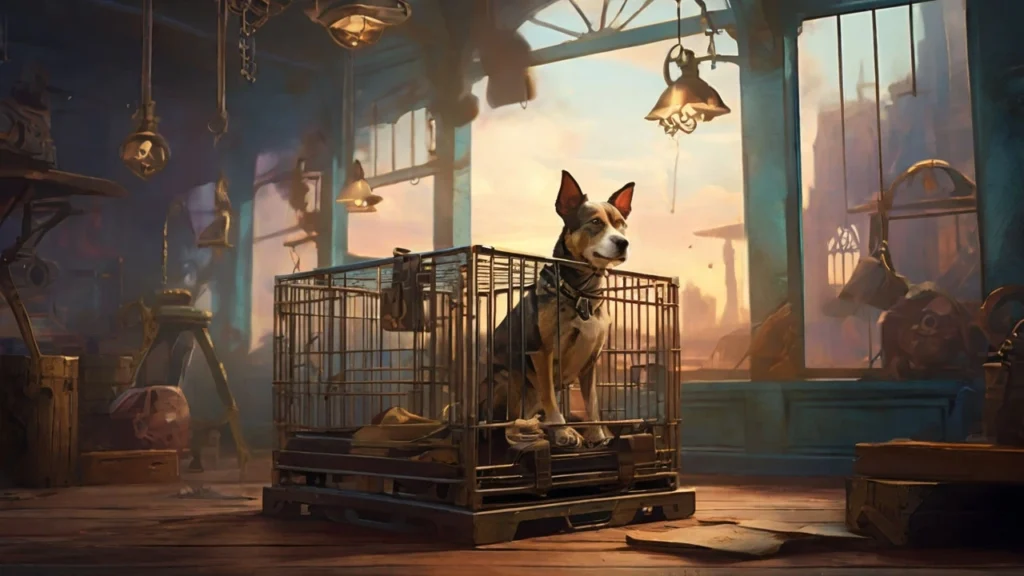
Your puppy makes noises for different reasons. You must know why your puppy barks or whines to help them better. Your puppy may bark because they are scared or sad or want you to notice them. Knowing the reason lets you act the right way.
Distress Barking
Your puppy may bark because they are nervous or hurt. To help your puppy stop barking, be friendly and gentle to them, give them things they like, and try using a thing that makes a smell that calms them in the crate. Slowly getting your puppy used to the crate can also make them less nervous.
Demand Barking
Your puppy may bark because they want you to look at them. Please do not talk to them immediately to help your puppy stop barking. Instead, wait for them to be quiet before giving them attention, showing them that being silent is good.
Need for a Potty Break
Your puppy may whine or bark because they need to pee or poop. Watch your puppy and take them out quickly if they look like they can’t wait. Do this whenever your puppy needs to go so they learn that doing it outside is good.
How Your Puppy’s Eating and Drinking Schedule Affects Nighttime Potty Breaks
Your puppy must eat and drink at the right time to sleep well. Please do not give your puppy food or water before bed so they do not have to go out at night. Please do the same thing every night, so your puppy can hold it better.
Practice Consistent Crate Training
Your puppy will learn to love the crate if you do the same thing daily. Make a plan that fits your puppy’s day, and make the crate a good place for your puppy. Use the exact words, give your puppy a treat for being good, and take your puppy out for food, fun, and peeing and pooping. This will make your training easy and work well.
Helping Your Puppy Burn Pre-Bedtime Energy
Your puppy needs to have fun and exercise before bed. A little bit of playing or walking can make your puppy more calm and quiet in the crate. By making your puppy tired before sleeping, you help them sleep better at night.
Setting Up Your Puppy’s Crate Area for Nighttime Rest

Your puppy needs a nice and warm place to sleep in the crate at night. Put things they know and like, such as blankets, toys, or a soft bed, to make the place cozy. Try using a thing that makes a smell that relaxes your puppy and makes them less scared or worried.
Make Sure You Have the Right Size and Type of Puppy Crate
Your puppy needs a crate that fits them well and is safe. The crate should be big enough for your puppy to stand, turn, and lie down, but not too big. Pick a crate with holes or gaps for air to come in and out.
Calming Pheromone Diffuser
To make the crate a quiet place for your puppy, try using a thing that makes a smell that calms them. This thing lets out a fake smell like a mother dog’s, making your puppy feel better. Put this thing near the crate to make your puppy feel more secure.
Calming Snuggle Puppy
A soft toy that feels like another puppy can be a good friend for your puppy in the crate. These toys have a warm thing and a thing that makes a heartbeat sound like a real puppy. The warm and steady sound makes your puppy less stressed or lonely.
Should You Cover Your Puppy’s Crate?
Covering your puppy’s crate can provide a sense of security by creating a den-like atmosphere. A light, breathable cover can block out visual stimuli and reduce ambient light, promoting a conducive relaxing environment. Monitor your puppy’s response to determine if covering the crate enhances their comfort.
Your Puppy’s Preferred Bedding: Warm and Cozy or Minimal and Cool?
Understanding your puppy’s preferences for bedding is crucial. Some puppies enjoy a warm and cozy environment with soft blankets, while others prefer a minimal and relaxed setting. Pay attention to your puppy’s behavior and adjust the bedding to ensure a comfortable and inviting crate space.
Should You Have Water in Your Puppy’s Crate?
While keeping your puppy hydrated is essential, having water in the crate may lead to accidental spills or discomfort. Instead, provide water during the day and ensure your puppy has access to water before bedtime. This helps manage bathroom breaks and ensures a more comfortable sleep within the crate.
Examples of Nighttime Puppy Crate Setups
Creating a comfortable and inviting space for your puppy’s nighttime rest is pivotal for successful crate training. Consider placing soft bedding, familiar toys, and a snuggle-worthy blanket inside the crate. The goal is to make the crate an appealing and secure environment, ensuring your puppy feels relaxed and ready for a good night’s sleep.
Middle of the Night Puppy Potty Breaks
It is crucial to understand that puppies have smaller bladders and may need to relieve themselves during the night. Incorporate middle-of-the-night potty breaks into your routine, especially during the early stages of crate training. This proactive approach minimizes accidents and reinforces positive bathroom habits.
Pay Attention to Your Puppy’s Sleep Schedule
Observing and understanding your puppy’s natural sleep schedule aids in creating an effective nighttime routine. Puppies typically have shorter sleep cycles, so be attuned to their signals and plan crate time to align with their natural sleep patterns. This ensures a smoother transition into the crate without disrupting their rest.
Potty Break Schedules for Puppies
Establishing a consistent potty break schedule for puppies is vital. Take your puppy outside for a bathroom break before bedtime, and strategically plan additional breaks during the night. This proactive approach minimizes accidents and contributes to successful nighttime crate training.
Your Puppy’s Nighttime Schedule is Unique to Them
Recognize that each puppy is unique, and their nighttime schedule may vary. Some puppies may need more frequent bathroom breaks, while others adapt quickly to more extended sleep periods. Tailor your approach based on your puppy’s needs, ensuring a personalized and practical crate training experience.
All Business, No Pleasure
Nighttime potty breaks and crate interactions should be all business. Minimize playtime and keep interactions calm to reinforce the idea that nighttime is for sleep. This focused approach helps your puppy understand the purpose of crate time and fosters a sense of routine.
Have Potty Break Supplies Stocked by the Door
Streamline the process of nighttime potty breaks by having supplies readily available. Keep a leash, flashlight, and necessary cleanup items near the door. This ensures a quick and efficient outing, minimizing disruptions to your puppy’s sleep.
Accidents Can (and Probably Will) Happen
Accept that accidents are a normal part of crate training, especially during the initial stages. Instead of becoming frustrated, approach accidents with patience and use them as learning opportunities for you and your puppy.
Benefits of Crate Training
Crate training offers numerous benefits for both you and your puppy. It provides a safe and secure space for your furry friend, aids in housebreaking, prevents destructive behavior, and establishes a routine that contributes to overall well-being. Additionally, crate training can be a valuable tool for travel and helps manage your puppy’s behavior in various situations.
What to Do Before Your Puppy is Crate Trained
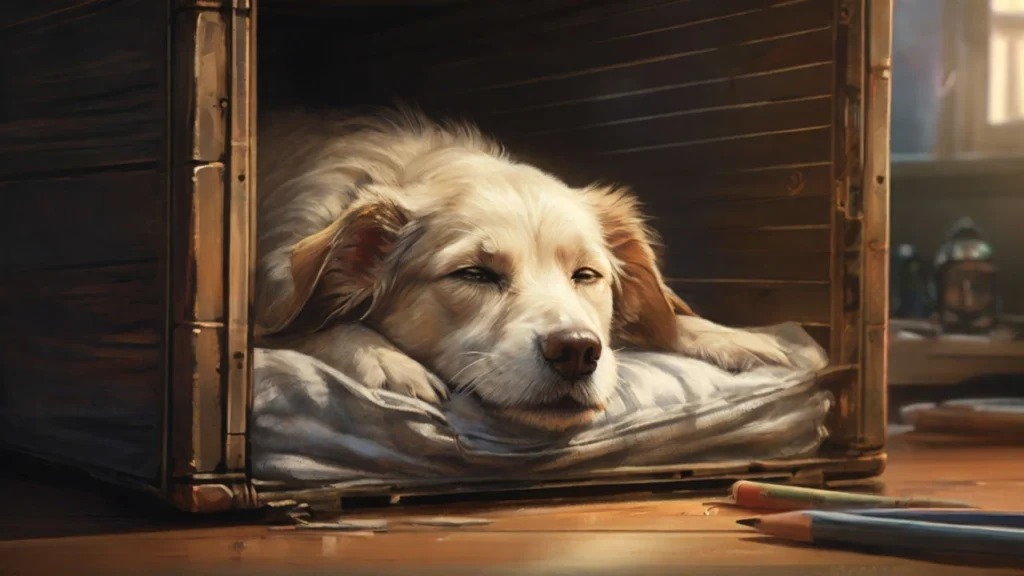
Before starting crate training:
- Familiarize your puppy with the crate gradually.
- Make it a positive space by placing treats and toys inside.
- Allow your puppy to explore the crate voluntarily, creating a sense of comfort and familiarity.
Crate Type and Size:
Selecting the right crate is essential for successful training. Common crate types include metal and plastic. The crate should be large enough for your puppy to stand, turn around, and lie comfortably without being excessively spacious.
Metal:
Metal crates provide ventilation and visibility, making them suitable for puppies who enjoy seeing their surroundings.
Plastic:
Plastic crates offer a more den-like atmosphere, providing your puppy with a cozy and enclosed space.
The Right Size:
Choosing the correct crate size is vital. It should be spacious enough for comfort but not too large to discourage bathroom accidents. Your puppy should have enough room to stand, turn, and lie comfortably.
Help Your Puppy Sleep Through the Night:
Facilitate a restful night’s sleep by incorporating a bedtime routine. Offer a bathroom break before crate time, provide a comfortable setup, and avoid stimulating activities close to bedtime. Consistency in the routine helps your puppy associate the crate with sleep.
The 4 Crucial Roles Of Nighttime Crate Training:
- Provides Safety & Security: The crate serves as a secure space, offering safety and comfort to your puppy during the night.
- Preventing Destructive Behavior: Nighttime crate training helps prevent destructive behaviors by restricting access to potential hazards.
- Helpful In Nighttime Potty Training: Crate training aids in nighttime potty training by encouraging your puppy to hold their bladder until an appropriate bathroom break.
- Let’s You Have A Peaceful Night Snooze: Enjoy uninterrupted sleep, knowing your puppy is safe and content in their crate, promoting a peaceful night for you and your furry companion.
The Golden Rules Of Crate Training You Should Never Forget:
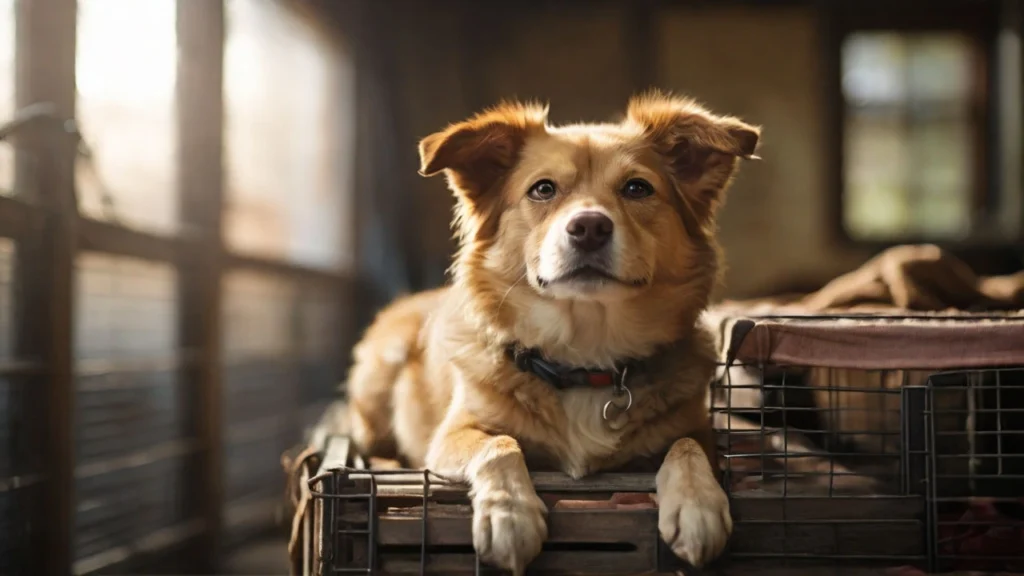
Not Using It As A Punishment:
The crate should never be associated with punishment. Maintain a positive and rewarding atmosphere during crate time.
Choosing The Right Crate Size:
Select a crate size that provides comfort without being overly spacious, discouraging bathroom accidents.
Some Crates To Consider:
Gunner G1 Kennel
Known for durability and safety features, the Gunner G1 Kennel provides a robust option for crate training.
DAKOTA 283 G3 Framed Door Kennel – Large – Orange
This kennel offers a sturdy construction with a framed door, ensuring security and comfort for your puppy.
Petmate Vari Dog Kennel
The Petmate Vari Dog Kennel is versatile, providing ample ventilation and visibility.
LEMBERI inch Heavy Duty Indestructible Dog Crate with Removable Tray
Known for its heavy-duty design, this crate offers durability and security for crate training.
No Leash Rule Inside:
Establish a “no leash” rule inside the crate to avoid potential hazards. Remove collars or harnesses before crating to ensure safety during rest.
How Long Can You Keep Your Dog Inside the Crate?
The length of time your dog can stay in the crate depends on age, breed, and individual needs. As a general guideline, adult dogs can typically tolerate more extended periods, while puppies require more frequent breaks.
Crate training is a valuable tool that contributes to a positive and harmonious relationship between you and your puppy when approached with care and consideration. Understanding the benefits, implementing the proper techniques, and selecting appropriate equipment enhance the overall effectiveness of crate training.
Create a Bedtime Routine Before Crate Time:
Establishing a consistent bedtime routine before crate time helps signal your puppy that it’s time for rest. Include activities such as a calming walk, gentle playtime, or a bathroom break. Creating a predictable routine aids in preparing your puppy for crate time, promoting a smoother transition into their nighttime sanctuary.
Create a Winding-down Routine:
Implement a winding-down routine to help your puppy relax before entering the crate. Dim the lights, engage in calming activities, and avoid stimulating play. This gradual transition prepares your puppy for a peaceful sleep within the crate.
How to Handle Whining and Barking:
Whining and barking are common behaviors during the initial stages of crate training. To address this, be patient and avoid responding immediately to vocalizations. Wait for a moment of quiet before providing attention or opening the crate. Consistency in your response helps your puppy understand that calm behavior is rewarded.
Be Consistent:
Consistency is paramount in crate training. Stick to a routine, use the same commands, and reinforce positive behavior consistently. Avoid deviations from the established plan to provide your puppy with a clear understanding of expectations. Consistency fosters a sense of security and helps your puppy adapt to the crate more effectively.
Conclusion:
In conclusion, crate training is a journey that requires dedication, patience, and a thoughtful approach to ensure the well-being and comfort of both you and your puppy. You create an environment that fosters positive associations with the crate by strategically selecting the crate location, establishing a consistent bedtime routine, and being mindful of food and water timing. A winding-down routine helps your puppy transition smoothly into their nighttime sanctuary, promoting a restful night’s sleep.
Addressing whining and barking with patience and consistency is crucial, reinforcing the understanding that calm behavior is rewarded. Be diligent in your efforts, maintain a positive atmosphere, and avoid using the crate as a punishment to build trust and a strong bond between you and your furry companion.
Remember that crate training is a unique process for each puppy, requiring flexibility to accommodate individual needs. Through this journey, you provide safety and security for your puppy, prevent destructive behaviors, and facilitate effective nighttime potty training.
In essence, crate training is an investment in the harmonious coexistence of you and your puppy. As you navigate this process with care, you’ll witness the development of a positive and trusting relationship, ensuring that the crate becomes a comforting haven for your furry friend.


